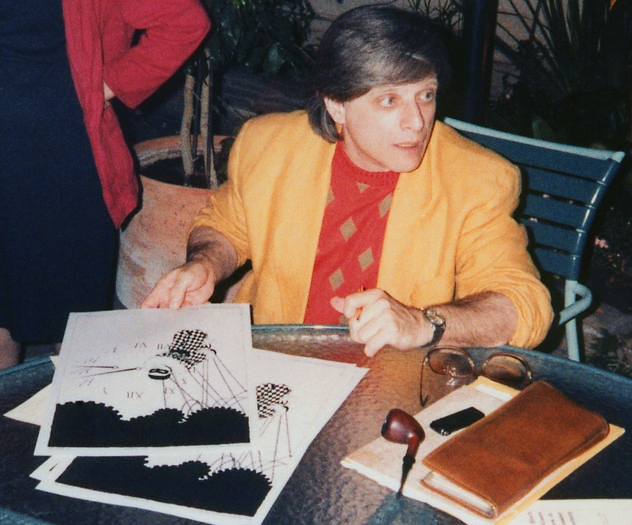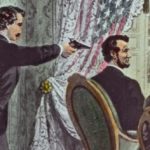 Technology
Technology  Technology
Technology  Humans
Humans 10 Everyday Human Behaviors That Are Actually Survival Instincts
 Animals
Animals 10 Animals That Humiliated and Harmed Historical Leaders
 History
History 10 Most Influential Protests in Modern History
 Creepy
Creepy 10 More Representations of Death from Myth, Legend, and Folktale
 Technology
Technology 10 Scientific Breakthroughs of 2025 That’ll Change Everything
 Our World
Our World 10 Ways Icelandic Culture Makes Other Countries Look Boring
 Misconceptions
Misconceptions 10 Common Misconceptions About the Victorian Era
 Mysteries
Mysteries 10 Strange Unexplained Mysteries of 2025
 Miscellaneous
Miscellaneous 10 of History’s Most Bell-Ringing Finishing Moves
 Technology
Technology Top 10 Everyday Tech Buzzwords That Hide a Darker Past
 Humans
Humans 10 Everyday Human Behaviors That Are Actually Survival Instincts
 Animals
Animals 10 Animals That Humiliated and Harmed Historical Leaders
Who's Behind Listverse?

Jamie Frater
Head Editor
Jamie founded Listverse due to an insatiable desire to share fascinating, obscure, and bizarre facts. He has been a guest speaker on numerous national radio and television stations and is a five time published author.
More About Us History
History 10 Most Influential Protests in Modern History
 Creepy
Creepy 10 More Representations of Death from Myth, Legend, and Folktale
 Technology
Technology 10 Scientific Breakthroughs of 2025 That’ll Change Everything
 Our World
Our World 10 Ways Icelandic Culture Makes Other Countries Look Boring
 Misconceptions
Misconceptions 10 Common Misconceptions About the Victorian Era
 Mysteries
Mysteries 10 Strange Unexplained Mysteries of 2025
 Miscellaneous
Miscellaneous 10 of History’s Most Bell-Ringing Finishing Moves
10 Artists Who Hated Their Own Masterpieces
Success can be a double-edged blade for an artist. On the one hand, you get to reap the benefits of your talent—fame, money, recognition. On the other hand, you risk falling into a niche you might not want to adhere to. You become really well known for that one particular thing, and people expect you to replicate it without deviation, forever and ever.
If you’re a painter, you are expected to use the same style in all of your works. If you are a singer, you are expected to perform your really big hit every chance you get. Get a few years (or even a few decades) of this, and you might begin to loathe your own creation.
10Radiohead
“Creep”
Just to establish its credentials, “Creep” was Radiohead’s first single. It was the song that made them famous and popular, and VH1 named it the 31st best song of the ’90s. However, the band—front man Thom Yorke, in particular—isn’t too keen on the song.
Initially, “Creep” didn’t do too well in the UK. It did, however, prove to be popular in certain countries, such as Israel, Spain, and New Zealand. This prompted the band to tour in those countries, promoting “Creep” heavily in order to gain recognition. Eventually, the song became successful in the US, and it saw a re-release in the UK, this time to a more enthusiastic response. However, pretty soon, the band became known only for that song. This proved to be very annoying, especially for Yorke, whom most fans identified as the man talked about in the song.
Over the years, that annoyance turned to hate. The band regularly dismissed requests to perform the song live. During one concert in Montreal, Yorke shouted “f–ck off, we’re tired of it” when fans requested Radiohead’s old hit and even called those who like the song “anally retarded,” whatever that’s supposed to mean. When the band did Glastonbury in 2003, a rumor persisted that they were looking for someone else to play “Creep” for them. The rumor turned out to be true: “Creep” was used to close out the concert . . . sung by Moby.
9Woody Allen
Manhattan
Manhattan is a 1979 romantic comedy written, directed, and featuring Woody Allen. It is noted for its distinct look (it was shot in black-and-white and in widescreen), its heartfelt story, and beautiful soundtrack. When it came out, it was a big hit both with the critics and the viewing public. Adjusted for inflation, it remains Woody Allen’s second most financially successful movie. And if you ask the critics, many would say that it is the best movie Woody Allen ever made. But the man himself is not a fan.
To be fair, Allen has always been a harsh critic of his own work. He does not think he’s ever made a great film. Allen sees even his classics—such as Annie Hall and the aforementioned Manhattan—as okay films that will not stand the test of time. He has a real problem with Manhattan in particular. When the movie came out, Allen was so disappointed with it that he begged United Artists not to release it. He even offered to do another movie for free just to keep it from coming out.
8Bruce Springsteen
Born To Run
There are plenty of examples out there of artists who end up hating some of their most successful songs. However, Bruce Springsteen took it one step further—he hated his entire Born to Run album. This is the same album that sold over six million copies in the US alone; the same album that was named “magnificent” by Rolling Stone and later named the 18th greatest album of all time.
Expectations were pretty high for this third album. The first two set Springsteen up as the next big thing (he was even touted as the next Bob Dylan) but still failed to garner him massive commercial success. This album was seen as a make-or-break situation, as far as Springsteen’s musical career went. That is why “The Boss” was determined to make the “greatest rock ‘n’ roll record ever made,” and he took his sweet time doing it. He spent most of 1974 on the album. It took Springsteen six months just to work on the main single, the eponymous “Born to Run.” And, according to the band, all the other songs required epic recording sessions as well.
Then, finally, the album was ready, and Springsteen was so miserable that he couldn’t stand to listen to it. According to him, it was the “worst piece of garbage” he’d ever heard. Unsurprisingly, Springsteen didn’t want to release it but was eventually convinced to do so by producer Jon Landau.
7Michelangelo
Pieta
We’re not talking about the famous Pieta with Mary Magdalene holding Christ after the crucifixion. We’re talking about another work of Michelangelo’s, referred to as the Florentine Pieta or The Deposition. It features the dead body of Christ being held by Mary Magdalene, the Virgin Mary, and a hooded man who has at different times been identified either as Joseph of Arimathea, St. Nicodemus, or a self-portrait of Michelangelo himself. The statue is also notable for depicting Jesus with just one leg. This wasn’t due to a design choice but rather because Michelangelo had stopped working on it.
There’s a certain mystery surrounding this statue, because we’re not sure what made Michelangelo turn on it so fervently. Originally, it was intended to go atop his tomb. The artist started work on it when he was 72, and for eight years he worked tirelessly on the Pieta. And then, one day, Michelangelo decided he hated it and started smashing it to bits with a chisel. Vasari, an art historian and contemporary of Michelangelo, claimed that the artist wasn’t really satisfied with any of his later works or perhaps placed the blame on the poor quality of the marble.
Although Michelangelo intended to destroy it, he was eventually persuaded to sell the statue to Francesco Bandini, along with the broken pieces. Michelangelo also allowed another artist, Tiberio Calcagni, to continue work on the statue and repair it. Calcagni fixed most of the damage, but he died before the work was complete, leaving the Pieta the way it is today.
6Stanislaw Lem
The Astronauts

Today, Stanislaw Lem is regarded not only as one of the finest writers Poland has ever produced but one of the greatest sci-fi writers, period. With a writing career spanning over five decades, Lem wrote books that sold tens of millions of copies and were translated into dozens of languages. And all of this started with The Astronauts.
This was Lem’s first book, published in 1951. It was an instant success and the turning point that convinced the author to pursue a career as a sci-fi writer. The book had many of the motifs that would become the hallmarks of Lem’s writing—interstellar travel, communication problems with alien civilizations, and so on. However, The Astronauts also had something Lem wasn’t too keen on: a communist utopia. The book is peppered with numerous references that exalt the virtues of communism, as it was targeted at a young audience. Lem did not want to do this, but he knew that it was necessary for his book to make it past the censorship of the Communist regime.
Later on, after Stalin was gone, Poland went through a period of de-Stalinization, and censorship laws became a bit more relaxed. During this time, Lem became a very prolific writer, authoring over a dozen books, but he also tried to distance himself from his earlier works. He tried to limit reissues of his first books, as he saw little value in them. Particularly when talking about The Astronauts, Lem claimed to be “a bit disgusted by this book.”
5Gerhard Richter
Photo-Based Paintings
In 2012, Gerhard Richter set a new record for the highest auction price fetched by a work from a living artist when his painting, Abstraktes Bild, sold for $34 million. This record was broken just a year later by a painting sold for $37.1 million, also by Richter. In other words, Gerhard Richter is one of the most successful and popular artists of our time.
He is also incredibly critical of his own work. In the past, Richter was quite willing to destroy his own paintings—not sketches but finished pieces that have even been put on exhibit—if he felt that they were subpar. Richter is an artist who enjoys working in a variety of styles. He did paintings, photographs, drawings; there’s even a stained glass window of his installed in Cologne Cathedral. One of his signature techniques used in the ’60s and ’70s involved photo-paintings: Richter would create blurry paintings based on real black-and-white photographs.
Some of these paintings were quite popular. Warship Destroyed by Torpedo, for example, was exhibited in his first ever gallery in 1964. Now it is gone forever, though, as the artist recently admitted to destroying that painting along with about 60 others that he was no longer pleased with. Modern estimates place the total value of the destroyed paintings at over $650 million. The artist did take photographs of the paintings before cutting them or throwing them in the fire. Only a few were published, while the rest remain in his private collection.
4Led Zeppelin
“Stairway To Heaven”
There really isn’t any need to present the credentials of “Stairway to Heaven,” but the gist of it is that it’s widely considered to be one of the greatest songs ever made. (As a sidenote, many DJs claim that they used to play the song so frequently because of its length, which made it ideal for a smoke break.) One thing that’s certain is that there is one man who absolutely loathes the song—the man who sings it, Robert Plant.
Plant got so fed up with having to finish every gig with that song and being asked about it in every interview that he now refers to it simply as that “damn wedding song.” For decades, he refused a Led Zeppelin reunion, because he didn’t want to sing “Stairway to Heaven” ever again. In an even more extreme move, Plant once pledged money to a radio station in Portland in order to get them to never play “Stairway to Heaven” again.
This caused problems in the band, as the hate wasn’t universal. In fact, guitarist Jimmy Page absolutely loves it—especially the long, epic, improvised solos he performs live. In fact, that was another reason why Plant hated the song. On the rare occasions when Led Zeppelin would reunite, Plant agreed to perform “Stairway to Heaven” only if it wasn’t played as the finale and if Page showed some restraint during the solo.
3Harlan Ellison
The Last Dangerous Visions

As an acclaimed sci-fi writer, Harlan Ellison also found success with Dangerous Visions, an award-winning anthology collected and edited by him, featuring stories from the greatest sci-fi writers. Authors like Isaac Asimov, Larry Niven, Phillip K. Dick, and, of course, Ellison himself have contributed stories to this collection.
A few years later, Ellison published Again, Dangerous Visions, a second anthology. It was another big hit with the sci-fi community. Naturally, just one year after that, Ellison announced work on a third anthology titled The Last Dangerous Visions. And then, for over 40 years . . . nothing. Despite being announced in 1973, that book is yet to be published. Why exactly, we don’t really know. Reportedly, it would have featured between 100–150 different authors (who have sold their stories to Ellison) and over one million words. Many of the writers are now dead, and most of the rest have given up on ever seeing their stories published. Only a handful have successfully withdrawn their stories and published them elsewhere.
The only author whose career was bolstered by the anthology was Christopher Priest. He was the first to withdraw and publish his story elsewhere. Priest also wrote a pamphlet criticizing Ellison called The Last Deadloss Visions. The pamphlet proved to be so popular that it was eventually turned into a book titled The Book on the Edge of Forever, which was nominated for a Hugo Award. As for Ellison, he still maintains that he would like the anthology to come out, although he has also instructed his wife to burn all of his unfinished work when he dies.
2Claude Monet
Water Landscapes

Monet’s Water Lilies is perhaps the most well-known series of paintings in history. And there are a lot of them. In fact, these landscape paintings became the main focus for Monet during the last 30 years of his career. There are around 250 oil paintings today, most of them either in museums or in private collections. However, there could have been many more—Monet destroyed a lot of his paintings.
This behavior is attributed to several factors. For one, Monet suffered from cataracts in his old age, so his increasingly poor eyesight was a constant source of frustration. This means that several paintings could have simply not been good enough. However, his bad eyesight also contributed to bouts of depression. Letters belonging to Alice Monet reveal how the well-being of a painting basically depended on the mood of the artist. One day, everything would be fine, and then the next day Monet would puncture the canvass with a knife. According to Monet, he destroyed at least 30 canvasses this way. On one occasion in 1908, he destroyed 15 major works right before they were due to be exhibited at the Durand-Ruel gallery in Paris.
1Tony Kaye
American History X
IMDb lists American History X as the 32nd best movie of all time. In addition, the movie garnered an Oscar nomination for Best Actor, as well as numerous other accolades, mostly singling out Edward Norton’s performance. It was director Tony Kaye’s feature film debut after directing several successful music videos, so you would think he was quite pleased with himself. You would be wrong.
Kaye was not at all happy with the final cut. In his own words, he was a “spectacular pain in the ass.” This being his first foray into Hollywood, Kaye thought that the director was supposed to be this lonely pirate fighting against a corporation trying to destroy his vision. New Line Cinema didn’t agree with this idea, and soon Kaye lost editing control, mostly in favor of Norton. (So Kaye turned out to be right, but not the way he wanted to be.)
When Kaye found out that Norton’s version was the one the studio decided to use, he started going to great lengths to sabotage the movie. First, he started taking out full-page ads in Variety trashing the film. He placed over 40 ads, spending over $1 million of his own money. When American History X got accepted into the Toronto Film Festival, Kaye flew all the way from Germany to Canada and demanded that the film be pulled. The weirdest part came when Kaye attended a meeting with New Line bigwigs accompanied by a priest, a monk, and a rabbi, hoping for some kind of divine intervention.
Radu tweets on occasion.








